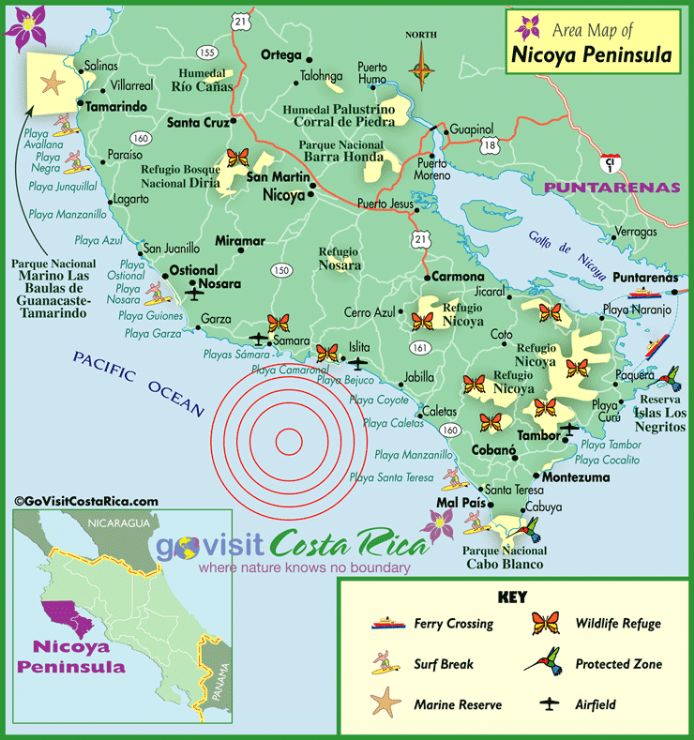
Nicoya Peninsula Samara Earthquake Map Sept 5, 2012
Samara Earthquake Sept 5, 2012
On the morning of September 5, 2012, as I was hopping through the rainforest, the ground began to tremble! It was so loud and scary, that the other animals in the jungle and I didn't know what was going on! Apparently, it was an earthquake, and I overheard the local townsfolk saying that the epicenter was located around 85 miles west of San Jose just off the coast of Samara. So, I did what any tree frog would do - I ran! When I eventually got to the nearest town, the earthquake was all over the news, so I went to find out what was going on.
One of the local news outlets, Telenoticias 7, said that in the hour after the quake began, there were as many as 25 aftershocks! Apparently, the tremor was caused by tectonic plates crashing into one another more than 20 miles underground. Some officials warned that further aftershocks may continue long after the initial quake subsided.
La Nacion reports that the earthquake was the second-strongest ever recorded in Costa Rica! The last time a quake of this magnitude hit the country was in 1822, when a temblor measuring 7.6 on the Richter Scale was reported in San Estanislao, in the province of Cartago. Both of these big quakes really shook the country up, but we were luck enough to get out of both without any serious damage!
7 Days / 6 Nights
Starting at $779 per person
The Associated Press reports that the initial magnitude was 7.9, but this was quickly downgraded. Although the quake only lasted for about 30 seconds, it felt much longer, and was felt as far away as neighboring Nicaragua and Panama. Some schools in Nicaragua were evacuated following the tremor - better to be on the safe side!
"So far, we don't have victims," said Kenia Campos, a city official in nearby Hojancha, one of the towns closest to the epicenter of the quake, as quoted by the news source. "People were really scared. We have had moderate quakes but an earthquake [this strong] hadn't happened in more than 50 years."
A lot of people were really scared, as we don't get many earthquakes in Costa Rica, but some experts said that this has been a long time coming. During the past 10 years, geological experts have warned that the area where the quake was centered - the Nicoya Peninsula - was at particular risk of another quake, as this is where Costa Rica's last earthquake struck almost 50 years ago.
Fortunately, there hasn't been much damage, and experts lifted the tsunami warning with a few hours. It was really scary, but we were lucky to get off easy - especially with how big this quake was!
The Aftermath of the Samara Earthquake
Although it could have been a lot worse, the earthquake that struck Costa Rica earlier this week has left a lot of people confused and scared - including me! Television news crews are all over the place, reporting on the damage caused by the quake. I followed some of them around to find out what's happening in the aftermath of the earthquake.
Localized damage
Fortunately, damage from the temblor was limited. People are saying that the towns of Sarchi, Zarcero,Tapezco and Grecia were the worst hit, with many people losing their homes in the quake. It could have been much worse, but it must be a terrible shock to lose your house like that.
Other areas, including Nicoya, Nosara and Samara have all been affected by heavy landslides, and there have been reports of widespread damage to several churches, government buildings and the Caja del Seguro. Sadly, it wasn't just homes that were destroyed in the quake. The Monseñor Sanabria hospital in Puntarenas also sustained major damage during the quake.
Road closures
Earthquakes often cause landslides, and this one was no exception. I overheard news crews reporting that several major roads have been closed, including the roads surrounding Ciudad Quesada and San Carlos. Laura Chinchilla, the president of Costa Rica, has been visiting each province in the country to see the damage for herself and reassure people that the government is doing everything it can to get the situation under control.
School's out
It's often said that it's better to be safe than sorry, and that seems to be the approach education officials in Guanacaste are taking. Although the area suffered much less damage and disruption than other areas, all kindergarten, high school and college classes in the province have been canceled for the time being.
Aftershocks
Apparently, there were around 540 aftershocks following the quake! Most of them have been between 3 and 5 on the Richter Scale, which is pretty typical after a tremor of this magnitude. Things are back to normal because everyone pitched in to help.

